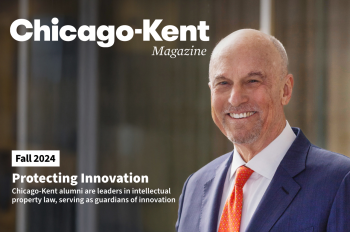IIT WINS 2003 BURNHAM AWARD FOR EXCELLENCE IN PLANNING
Chicago, IL — June 18, 2003 —
The Illinois Institute of Technology’s (IIT) main campus is an archetype of the urban university. It is bisected by the CTA Green Line and bordered on the north and south by public housing complexes that are, today, being transformed into mixed-income communities. Many of its buildings are historically and architecturally significant, and the campus has long been an oasis of prosperity in an otherwise bleak environment.
In 1995, IIT initiated a main campus master planning process to review Ludwig Mies van der Rohe’s original 1940 plan and address the university’s critical growth issues and IIT’s role in the revitalization of the State Street corridor. Architect and IIT Board of Trustees member Dirk Lohan was called upon to lead the process his grandfather began. The result is a bold statement that is at once innovative and traditional in its approach, earning IIT the Metropolitan Planning Council’s 2003 Burnham Award for Excellence in Planning for its Main Campus Master Plan.
“The selection committee was impressed with the way in which the Master Plan touches on so many aspects of community development,” said Terry Perucca, president of Bank of America in Illinois, and presenter of the Burnham Award. “The IIT campus is gaining renown for its strong commitment to help stimulate the revitalization of the surrounding community. The school even had the foresight to organize a class to give students an opportunity to look at the issues surrounding the preservation of an old church in the neighborhood.”
IIT is clear that it has a relationship of mutual interdependence with its neighbors. The Main Campus Plan has a broad, forward-looking and comprehensive vision that will unify the physical campus and better integrate it into the neighborhood. “The main purpose of the Master Plan is to close the many gaps and reconnect the fabric of IIT’s facilities into a vibrant, urban and attractive environment,” said Dirk Lohan.
Construction of the new McCormick Tribune Campus Center, designed by noted Dutch architect Rem Koolhaas, is in its final stages and set to open Sept. 30, 2003. The Center unifies the IIT campus both literally and figuratively — turning no-man’s land under the CTA’s elevated train tracks into the focus of student activity — linking campus residential and academic areas. Helmut Jahn’s neighboring student residence hall, the new “State Street Village,” is also nearing completion and will open July 22, 2003.
With the first phase of the plan nearly complete, IIT and Lohan Caprile Goettsch architects are moving forward with a master plan update that calls for additional new residence halls, new parking structures, a president’s residence, hotel and new commercial activity on the south end of the campus.
“Our Main Campus is not an island. We have never lost sight that IIT is part of a larger neighborhood,” said IIT President Lew Collens. “One of our challenges has been to ensure that the revitalization we bring to IIT has an equally positive impact on the overall neighborhood. Our Master Plan proposes new residential construction not just on campus but in the surrounding community, creating a ‘campus-in-the-park’ setting. Improvements to major city traffic arteries have made the entire area more pedestrian-friendly. Nearly 100 trees and 20,000 ground covering plants were added in the last year alone.”
IIT’s commitment to stay in Bronzeville was a key factor in getting the City of Chicago to invest in a new Police Department Headquarters at the southern edge of campus. In addition, IIT has, for the first time in its more than 100-year history, initiated a process to create a residential community for faculty and staff adjacent to its main campus.
“We felt it was a crucial component to develop more informal exchanges between students and faculty, enlivening the campus environment and strengthening the link to the surrounding community,” said Collens. “IIT is a partner in developing new residential communities like the adjacent Michigan Place condominiums in 2000. This year, we announced an employer-assisted housing program for our faculty and staff to buy homes in the planned redevelopment of Stateway Gardens,” he added. “It’s more than just coming to work here everyday. It’s about calling it home, too.”
“IIT’s Main Campus Master Plan is a real life example of what can happen when urban institutions collaborate with and invest in a neighborhood – in their neighborhood,” said Peter Skosey, MPC’s vice president of external relations. “MPC is proud to honor IIT and Lohan Caprile Goettsch with this year’s Burnham Award, which recognizes planning efforts –in the private, civic, or government area – that raise both professional standards and our spirits as residents of the region.”
Now in its 16th year, the Burnham Award for Excellence in Planning is presented annually at the Metropolitan Planning Council’s Annual Meeting Luncheon. This year’s award carries a $5,000 cash prize underwritten by Bank of America. MPC’s luncheon, on June 23 at the Hilton Chicago & Towers, will feature keynote remarks by U.S. Rep. J. Dennis Hastert, speaker of the House, on the impact of federal legislation on critical regional issues.
Founded in 1890, IIT is a Ph.D.-granting technological university awarding degrees in the sciences, mathematics and engineering, as well as architecture, psychology, design, business and law. IIT’s interprofessional, technology-focused curriculum prepares the university’s 6,200 students for leadership roles in an increasingly complex and culturally diverse global workplace.




